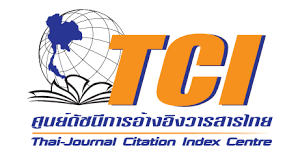ความชุกและปัจจัยที่สัมพันธ์กับการติดเชื้อราที่ผิวหนังชั้นตื้น ของผู้ป่วยที่เข้ารับการรักษาในโรงพยาบาลสังกัดกระทรวงสาธารณสุข จังหวัดตรัง
คำสำคัญ:
การติดเชื้อราที่ผิวหนังชั้นตื้น, โรงพยาบาล, จังหวัดตรังบทคัดย่อ
การวิจัยนี้เป็นการวิวัยเชิงสำรวจภาคตัดขวาง เพื่อศึกษาความชุกและปัจจัยที่สัมพันธ์ต่อการเกิดโรคติดเชื้อราที่ผิวหนังชั้นตื้นของผู้ป่วยที่เข้ารับการรักษาในโรงพยาบาลสังกัดกระทรวงสาธารณสุข จังหวัดตรัง เก็บรวบรวมข้อมูลโดยใช้ข้อมูลทุติยภูมิจากระบบฐานข้อมูลของผู้ป่วยที่มาตรวจรักษาที่โรงพยาบาลในสังกัดกระทรวงสาธารณสุข ในเขตจังหวัดตรัง ย้อนหลัง 3 ปี ตั้งแต่วันที่ 1 มกราคม 2564 ถึงวันที่ 31 ธันวาคม 2566 จำนวนทั้งสิ้น 1,342 ราย ซึ่งเป็นผู้ที่ได้รับการวินิจฉัยว่าเป็นโรคติดเชื้อราที่ผิวหนังชั้นตื้นและมีผลตรวจทางห้องปฏิบัติการ KOH preparation ยืนยันการวินิจฉัย วิเคราะห์ข้อมูลด้วยสถิติ Multiple Logistic Regression
ผลการศึกษาพบว่าความชุกของการติดเชื้อราที่ผิวหนังชั้นตื้นของผู้ป่วยที่เข้ารับการรักษาในโรงพยาบาลสังกัดกระทรวงสาธารณสุข จังหวัดตรัง คือร้อยละ 33.2 โดยโรคติดเชื้อแคนดิดามีความชุกมากที่สุดคือ ร้อยละ 17.4 รองลงมาคือโรคกลาก ร้อยละ 13.9 และโรคเกลื้อน ร้อยละ 1.9 ตามลำดับ อำเภอที่มีความชุกของการติดเชื้อราที่ผิวหนังชั้นตื้นมากที่สุด ได้แก่ อำเภอหาดสำราญ ร้อยละ 58.18 รองลงมาคือ อำเภอห้วยยอด อำเภอวังวิเศษ และอำเภอปะเหลียน ตามลำดับ ปัจจัยที่มีความสัมพันธ์ต่อการติดเชื้อราที่ผิวหนังชั้นตื้นอย่างมีนัยสำคัญทางสถิติ ได้แก่ 1) ภูมิลำเนาของผู้ป่วย กล่าวคือ อำเภอหาดสำราญ อำเภอห้วยยอด อำเภอวังวิเศษ อำเภอปะเหลียน และอำเภอเมือง มีความเสี่ยงที่ติดเชื้อราที่ผิวหนังชั้นตื้น มากกว่าอำเภอย่านตาขาว มีค่า OR เท่ากับ 7.73, 5.60, 4.06, 2.95 และ 2.15 เท่า ตามลำดับ 2) สถานภาพสมรส โดยที่ผู้ป่วยที่มีสถานะโสด จะมีโอกาสที่จะติดเชื้อราที่ผิวหนังชั้นตื้นมากกว่าผู้ป่วยที่มีแต่งงานแล้ว 1.49 เท่า และผู้ป่วยที่มีสถานะอื่นๆ (หย่าร้าง หม้าย) มีโอกาสติดเชื้อราที่ผิวหนังชั้นตื้นมากกว่าผู้ป่วยที่แต่งงานแล้ว 1.86 เท่า 3) การสูบบุหรี่ กล่าวคือผู้สูบบุหรี่ มีโอกาสที่ติดเชื้อราที่ผิวหนังชั้นตื้นน้อยกว่าผู้ป่วยที่ไม่สูบบุหรี่ หรือมีโอกาสที่ติดเชื้อราที่ผิวหนังชั้นตื้นลดลง 47% สำหรับปัจจัยอื่นๆ ได้แก่ ระดับการศึกษา ศาสนา อาชีพ และดัชนีมวลกาย ไม่พบนัยสำคัญทางสถิติ (p-value > 0.05) ถึงแม้ว่าปัจจัยด้านอาชีพและดัชนีมวลกาย ไม่พบนัยสำคัญทางสถิติ แต่พบว่า ผู้ป่วยที่มีอาชีพเป็นพนังงานทั่วไป รับจ้างทั่วไป เกษตรกร หรือข้าราชการ มีโอกาสที่ติดเชื้อราที่ผิวหนังชั้นตื้นมากกว่าผู้ป่วยที่มีอาชีพเป็นค้าขายหรือประกอบธุรกิจส่วนตัวอย่างมีนัยสำคัญทางสถิติ (p-value < 0.05) ผู้ป่วยที่ดัชนีมวลกายเกินค่าปกติ มีโอกาสติดเชื้อราที่ผิวหนังชั้นตื้นมากกว่าผู้ป่วยที่ดัชนีมวลกายปกติอย่างมีนัยสำคัญทางสถิติ (p-value < 0.05) ข้อค้นพบจากการศึกษานี้สามารถนำไปใช้เฝ้าระวัง ให้ความรู้ และวางแผนป้องกันการเกิดโรคติดเชื้อราที่ผิวหนังชั้นตื้นในกลุ่มเสี่ยง เช่น ในกลุ่มผู้มีภูมิลำเนาอยู่ในอำเภอหาดสำราญ ผู้ที่มีอาชีพรับจ้างหรือเกษตรกร หรือผู้ที่มีค่าดัชนีมวลกายเกินค่าปกติ เป็นต้น
เอกสารอ้างอิง
Ameen M. (2010). Epidemiology of superficial fungal infections. Clinics in dermatology., 28(2),
-201.
Baker LB. (2019) Physiology of sweat gland function: The roles of sweating and sweat
composition in human health.Temperature. 6(3):211-59.
Centers for Disease Control and Prevention. (2024). About Fungal Diseases.
https://www.cdc.gov/fungal/about/index.html#cdc_disease_basics_types-types
Chaiporn Wirotsaengarun. (2019). Histopathology of Cutaneous Fungal Infection. Faculty of
Medicine Naresuan University.http://www.med.nu.ac.th/dpMed/fileKnowledge/412_2023-
-14.pdf
Chayakulkeeree M, & Denning DW. (2017). Serious fungal infections in Thailand. European Journal
of Clinical Microbiology &Infectious Diseases. 36, 931-5.
GBD 2016 Disease and Injury Incidence and Prevalence Collaborators. (2017, September 16).
Global, regional, and national incidence, prevalence, and years lived with disability for 328
diseases and injuries for 195 countries, a systematic analysis for the Global Burden of Disease
Study 2016. Lancet, 390
Institute for Health Metrics and Evaluation. (2018). Findings from the Global Burden of Disease
Study 2017.Institute of Dermatology Department of Medical Services, Ministry of Public
Health. (2023). Statistical report for fiscal year 2023. Institute of Dermatology. https://www.iod.go.th/
Kattaleeya Mekjaratsakul. (2017, October 25). Percutaneous absorption. Center for Continuing
Pharmacy Education.https://shorturl.asia/5tmcQ
Khodadadi H, et al. (2021), Zomorodian K, Nouraei H, Zareshahrabadi Z, Barzegar S, Zare MR, &
Pakshir K. Prevalence of superficial‐cutaneous fungal infections in Shiraz, Iran: A five‐year
retrospective study (2015–2019). Journal of Clinical Laboratory Analysis, 35(Suppl. 7),
e23850.
Phirun Mutsikapan. (2016). Common fungal diseases. Update from Infectious Disease Association
of Thailand. 11-14
Rasid S, Muthupalaniappen L, & Jamil A. (2020). A. Prevalence and factors associated with
cutaneous manifestations of type 2 diabetes mellitus. Clinical Diabetology, 9(Suppl. 6), 461-8.
Salinee Rojhiransakul, & Somyot Jaruwijitratana. (n.d.) Procedure and basic investigation in dermatology. Rama.Mahidol. https://www.rama.mahidol.ac.th/ramalaser/sites/default/files/public/pdf/course/Procedure.and.basic.investigation.in.dermatology.pdf
Sarker F, Akter T, Musa S, Bhuiyan AI, Khan MM, & Khanum H. (2021). Fungal Skin Diseases and
Related Factors in Outpatients of Three Tertiary Care Hospitals of Dhaka, an Urban City of
Bangladesh: Cross-Sectional Study. Biomed J Sci & Tech Res, 39(Suppl. 1), 30926-3.
Southern Regional hospital of Tropical Dermatology, Trang Province. (2023). Annual Report-2023.
Trangskin.https://www.trangskin.go.th/
Thai Healthy organization. (2019, February 21). How obesity cause skin damage. Thai Health
Promotion Foundation.https://www.thaihealth.or.th
Trang Provincial Administrative Organization. (2020). General information about Trang Province
Trangpao.https://www.trangpao.go.th/content/general
Ungpakorn R., Ishinkin N., &Zasshi G. (2005). Mycoses in Thailand: current concerns., 46(Suppl.
, 81-6.
Urban K, Chu S, Scheufele C, Giesey RL, Mehrmal S, Uppal P, & Delost GR. (2017). The global,
regional, and national burden of fungal skin diseases in 195 countries and territories: A cross-
sectional analysis from the Global Burden of Disease Study 2017. JAAD (Suppl. 2), 22-27. doi:
1016/j.jdin.2020.10.003. PMID: 34409349; PMCID: PMC8362308.
Walters KA. (2002, February 20). Dermatological and transdermal formulations. CRC Press.
Wasarin Natpracha. (2021). Common skin diseases and basic care to prevent disease spreading. Navavej.com https://navavej.com/articles_d/18855/Skin_diseases
Wu BY, Wu BJ, Lee SM, Sun HJ, Chang YT, & Lin MW. (2014). Prevalence and associated factors of
comorbid skin diseases in patients with schizophrenia: a clinical survey and national health
database study. General hospital psychiatry, 36(Suppl. 4),415-21.
Yuparat Srichuay, Woraphon Wechachapinan, & Phakamon Damrongkanapat. (2024, March 11).
The study of Dermatophytosis among service recipients at The Southern Regional hospital of
Tropical Dermatology, Trang Province, 2019 – 2023. Trangskin. https://www.trangskin.go.th/dermatophytosis/#

ดาวน์โหลด
เผยแพร่แล้ว
รูปแบบการอ้างอิง
ฉบับ
ประเภทบทความ
สัญญาอนุญาต
ลิขสิทธิ์ (c) 2025 วารสารสาธารณสุขและวิทยาศาสตร์สุขภาพ

อนุญาตภายใต้เงื่อนไข Creative Commons Attribution-NonCommercial-NoDerivatives 4.0 International License.
บทความทุกบทความที่ได้รับการตีพิมพ์ถือเป็นลิขสิทธิ์ของ วารสารสาธารณสุข















